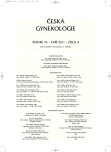Application of SNP array method in prenatal diagnosis
Authors:
V. Bečvářová 1; M. Hynek 1; M. Putzová 1; I. Soldátová 1; J. Horáček 1; D. Smetanová 1; E. Kulovaný 1; M. Matoušková 1; V. Krutílková 1; E. Hlavová 1; D. Rašková 1; M. Hejtmánková 1; K. Čutka 2; D. Čutka 2; D. Stejskal 1; R. Mihalová 3; M. Trková 1
Authors place of work:
Gennet, Centrum lékařské genetiky a reprodukční medicíny, Praha, vedoucí lékař MUDr. D. Stejskal
1; Centrum lékařské genetiky, České Budějovice, vedoucí lékař MUDr. K. Čutka
2; Ústav biologie a lékařské genetiky 1. LF UK a VFN, Praha, přednostka doc. MUDr. M. Kohoutová, CSc.
3
Published in the journal:
Ceska Gynekol 2011; 76(4): 261-267
Summary
Objectives:
SNP array (array method using Single Nucleotide Polymorphisms) enables to detect cytogenetically undetectable submicroscopic alterations (microdeletions, microduplications), which could be also causative for ultrasonographic anomalies of fetus. This article describes the principle, advantages, disadvantages and application possibilities of the SNP array method in prenatal diagnosis. The ten month experience with SNP array use in prenatal diagnosis is presented.
Design:
Prospective study.
Settings:
Gennet, Prague.
Material and methods:
During the period from April 2010 to January 2011 we performed 110 SNP array analyses of fetal DNA: 14 chorionic villi samples (CVS), 88 amniotic fluid samples (AMC), 1 cord blood sample and 7 miscarriage samples. Laboratory tests were carried out on DNA from both cultured and uncultured fetal cells. Examinations were performed in fetuses with sonographic abnormal findings having normal karyotype. In addition 14 fetal cytogenetic abnormalities were solved. SNP array analysis was performed using Illumina InfiniumHD HumanCytoSNP-12 chip. All data were analysed by Illumina KaryoStudio and GenomeStudio software.
Results:
SNP array analysis was performed in 108 fetuses (only 2 examination failures, 1.8%). In total, we detected CNV (copy number variation) in 29 samples (29/108 = 27%). 15% (16/108) of fetuses with abnormal ultrasound findings were found to carry clinically relevant CNV. Probably benign CNVs were found in 8 samples (8/108 = 7%) and in additional 5 CNVs parental samples have not been analysed yet. Excluding karyotypically abnormal cases clinically relevant CNVs were found in 10% of fetuses (9/94). In all cases with de novo chromosomal aberration the clinical relevancy was clarified (imbalances in 50%).
Conclusion:
Our data suggest that SNP array analysis is a relevant and useful technique in prenatal diagnosis.
Key words:
SNP array, CNV, prenatal diagnosis, ultrasound diagnosis.
Zdroje
1. Ahn, J., Mann, K., Walsh, S., et al. Validation and implementation of array comparative genomic hybridisation as a first line test in place of postnatal karyotyping for genome imbalance. Molecular Cytogen, 2010, 3, p. 9.
2. Faas, BHW., de Burgt, I., Kooper, AJA., et al. Identification of clinically significant submicroscopic chromosome alterations and UPD in fetuses with ultrasound anomalies using genome-wide 250k SNP array analysis. J Med Genet, 2010, 47, p. 586.
3. Kleeman, L., Bianchi, DW., Shaffer, LG., et al. Use of array comparative genomic hybridization for prenatal diagnosis of fetuses with sonographic anomalies and normal metaphase karyotype. Prenatal Diagnosis, 2009, 29, p. 1213.
4. Kotzot, D. Complex and segmental uniparental disomy updated. J Med Genet, 2008, 45, p. 545.
5. LaFramboise, T. Single nucleotide polymorphism arrays: a decade of biological, computational and technological advances. Nucleic Acids Res, 2009, 37, p. 4181.
6. Liehr, T. Cytogenetic contribution to uniparental disomy (UPD). Molecular Cytogen, 2010, 3, p. 8.
7. Miller, DT., Adam, MP., Aradhya, S., et al. Consensus Statement: Chromosomal microarray is a first-tier clinical diagnostic test for individuals with developmental disabilities or congenital anomalies. Am J Hum Genet, 2010, 86, p. 749.
8. Rajcan-Separović, E., Diego-Alvarez, D., Robinson, WP., et al. Identification of copy number variants in miscarriages from couples with idiopathic recurrent pregnancy loss. Human Reprod, 2010, 25, p. 2913.
9. Shaffer, LG., Bui, TH. Molecular cytogenetic and rapid aneuploidy detection methods in prenatal diagnosis. Am J Med Genet Part C, 2007, 145C, p. 87.
10. Shaikh, TH., Gai, X., Perin, JC., et al. High-resolution mapping and analysis of copy number variations in the human genome: A data resource for clinical and research applications. Genome Res, 2009, 19, p. 1682.
11. Tyreman, M., Abbott, KM., Willatt, LR., et al. High resolution array analysis: diagnosing pregnancies with abnormal ultrasound findings. J Med Genet, 2009, 46, p. 531.
12. Vermeesch, JR., Fiegler, H., de Leeuw, N., et al. Guidelines for molecular karyotyping in constitutional genetic diagnosis. Eur J Hum Genet, 2007, 15, p. 1105.
13. Vissers, LELM., de Vries, BBA., Veltman, JA. Genomic microarrays in mental retardation: from copy number variation to gene, from research to diagnosis. J Med Genet, 2010, 49, p. 289.
Web stránky(veřejně dostupné databáze):
14. Database of Chromosomal Imbalance and Phenotype in Humans using Ensembl Resources(DECIPHER), http://decipher.sanger. ac.uk/application/, verze v 5.1, GR Ch37
15. Database of Genomic Variants(DGV), http://projects.tcag.ca/ variation/, verze Human genome assembly hg.19, Human (GR Ch37).
16. UCSC Genome Bioinformatics Site, http://genome.ucsc.edu, verze Feb. 2009 (GR Ch37/hg19).
Štítky
Dětská gynekologie Gynekologie a porodnictví Reprodukční medicínaČlánek vyšel v časopise
Česká gynekologie

2011 Číslo 4
- Tirzepatid – nová éra v léčbě nadváhy a obezity
- Obezita je nemoc, kterou je třeba diagnostikovat a léčit
- Horní limit denní dávky vitaminu D: Jaké množství je ještě bezpečné?
- Postupné vysazování inhibitorů protonové pumpy
- Moje zkušenosti s Magnosolvem podávaným pacientům jako profylaxe migrény a u pacientů s diagnostikovanou spazmofilní tetanií i při normomagnezémii - MUDr. Dana Pecharová, neurolog
Nejčtenější v tomto čísle
- Trikuspidální regurgitace u plodu
- Aplikace metody SNP array v prenatální diagnostice
- Transabdominální ultrazvukové vyšetření v gynekologii
- Současná klasifikace zhoubných nádorů v onkogynekologii – část I
